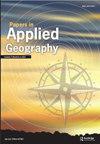Spatial development in the European Alps: Topographic Potential Area as a basic indicator for policy debates
Q2 Social Sciences
引用次数: 0
Abstract
ABSTRACTThe European Alps are characterized by a unique geographical environment. The high altitude and the associated steepness of the slopes pose numerous challenges for spatial development. Furthermore, due to their specific natural characteristics, the Alps constitute a region worthy of preservation, which brings additional considerations in the field of political decision-making. All these facts demand increased political and planning coordination.Debates about spatial development in the Alps, hardly address the regions’ topographic characteristics and their consequences. Based on a Digital Elevation Model (DEM) slope analysis, I argue that topographic factors and their implications for municipalities in the Alpine region have been underestimated in spatial development. In this article, an analytical mapping of the Alpine region based on topographic arguments addresses two research questions: What potentials and limits does slope data reveal for the Alps as a living space? How can this analysis help to identify potentials for spatial development in the Alps?I introduce the Topographic Potential Areas (TPA) and an associated TPA quotient, which relates the potential area based on slope steepness to the total area of the municipal territory. These findings serve as a basis for further analyses to facilitate a sustainable spatial organization of the Alpine region.Keywords: applied geomorphologyfeature extractionGISmappingspatial planningDisclaimerAs a service to authors and researchers we are providing this version of an accepted manuscript (AM). Copyediting, typesetting, and review of the resulting proofs will be undertaken on this manuscript before final publication of the Version of Record (VoR). During production and pre-press, errors may be discovered which could affect the content, and all legal disclaimers that apply to the journal relate to these versions also.欧洲阿尔卑斯山的空间发展:地形潜力区作为政策辩论的基本指标
摘要欧洲阿尔卑斯山具有独特的地理环境。高海拔和坡度的陡度给空间开发带来了许多挑战。此外,由于其特殊的自然特征,阿尔卑斯山构成了一个值得保护的地区,这在政治决策领域带来了额外的考虑。所有这些事实都要求加强政治和规划协调。关于阿尔卑斯地区空间发展的争论几乎没有涉及该地区的地形特征及其后果。基于数字高程模型(DEM)坡度分析,我认为地形因素及其对高寒地区城市的影响在空间发展中被低估了。在本文中,基于地形参数的高寒地区分析地图解决了两个研究问题:坡度数据揭示了阿尔卑斯山作为生活空间的哪些潜力和限制?这种分析如何有助于确定阿尔卑斯山的空间发展潜力?我介绍了地形潜在面积(TPA)和相关的TPA商,它将基于坡度的潜在面积与市政领土总面积联系起来。这些发现可作为进一步分析的基础,以促进阿尔卑斯地区的可持续空间组织。关键词:应用地貌学特征提取ismapping空间规划免责声明作为对作者和研究人员的服务,我们提供此版本的已接受稿件(AM)。在最终出版版本记录(VoR)之前,将对该手稿进行编辑、排版和审查。在制作和印前,可能会发现可能影响内容的错误,所有适用于期刊的法律免责声明也与这些版本有关。
本文章由计算机程序翻译,如有差异,请以英文原文为准。
求助全文
约1分钟内获得全文
求助全文

 求助内容:
求助内容: 应助结果提醒方式:
应助结果提醒方式:


